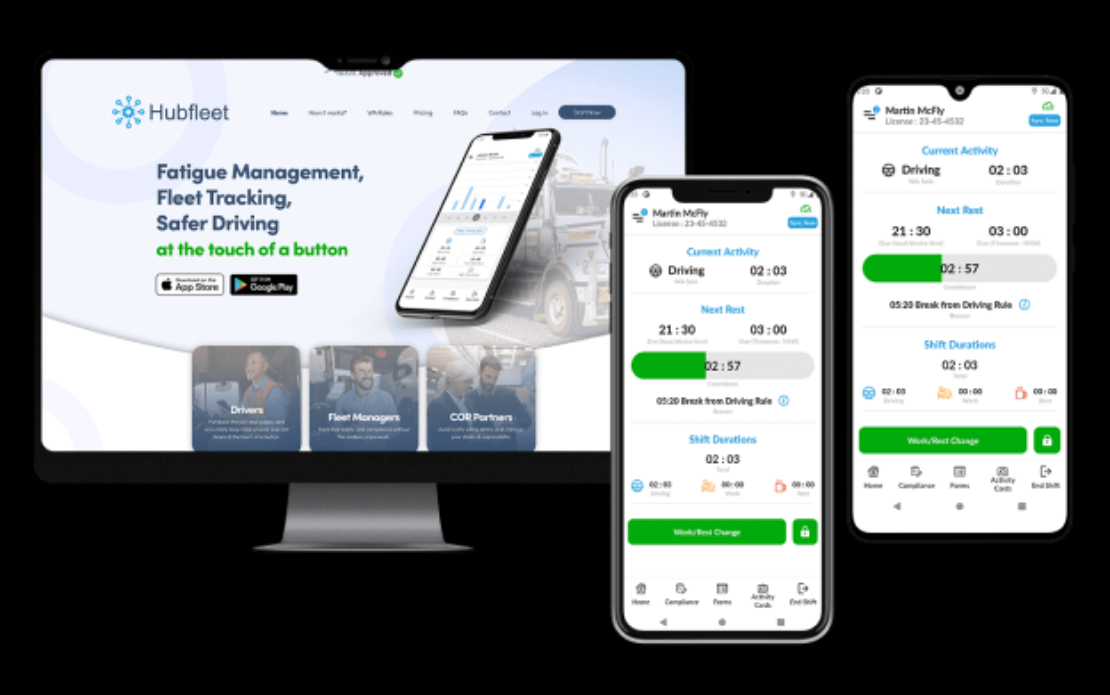
Challenge
Complex Fleet Operations: Managing a large fleet with diverse vehicle types, spread across different locations, posed challenges in terms of data consolidation, coordination, and real-time monitoring.
Real-time GPS and Geo-fencing Integration: Integrating a precise GPS tracking system that could offer real-time tracking and accurate geo-fencing was critical for ensuring vehicle safety and optimizing routes. However, ensuring data accuracy and minimal latency for real-time tracking was technically challenging.
Fatigue Management for Drivers: Implementing a fatigue management system required the development of algorithms that could assess driver behavior and alert the management and drivers about potential fatigue, ensuring road safety and compliance with regulations.
Vehicle Health Monitoring: Integrating vehicle diagnostics with the app to offer real-time monitoring of vehicle health indicators (engine performance, fuel consumption, etc.) was complex due to varying vehicle models and sensor data formats.
Cross-Platform Consistency: The application needed to be consistent across iOS, Android, and Web platforms, which required synchronized features, a unified user experience, and seamless integration across devices.
Complex Fleet Operations: Managing a large fleet with diverse vehicle types, spread across different locations, posed challenges in terms of data consolidation, coordination, and real-time monitoring.
Real-time GPS and Geo-fencing Integration: Integrating a precise GPS tracking system that could offer real-time tracking and accurate geo-fencing was critical for ensuring vehicle safety and optimizing routes. However, ensuring data accuracy and minimal latency for real-time tracking was technically challenging.
Fatigue Management for Drivers: Implementing a fatigue management system required the development of algorithms that could assess driver behavior and alert the management and drivers about potential fatigue, ensuring road safety and compliance with regulations.
Vehicle Health Monitoring: Integrating vehicle diagnostics with the app to offer real-time monitoring of vehicle health indicators (engine performance, fuel consumption, etc.) was complex due to varying vehicle models and sensor data formats.
Cross-Platform Consistency: The application needed to be consistent across iOS, Android, and Web platforms, which required synchronized features, a unified user experience, and seamless integration across devices.
Solution
Fleet Data Consolidation and Real-Time Visibility: We built a centralized fleet management dashboard that allowed managers to monitor and control all aspects of their fleet from a single interface. This included:
- Real-time vehicle locations via GPS.
- Alerts and notifications for unauthorized movements or geo-fence breaches.
- Detailed driver activity reports.
Accurate GPS Tracking & Geo-fencing: Using advanced GPS technology and geo-fencing APIs, the solution provided real-time updates on vehicle locations and notified managers when vehicles entered or left predefined zones. This helped in optimizing delivery routes, reducing fuel costs, and improving operational efficiency.
Fatigue Management System: We implemented a fatigue management system using a combination of time tracking, driving hours monitoring, and alerting mechanisms. The system automatically flagged drivers who exceeded legal or safe driving hours, providing real-time alerts to both the driver and fleet managers.
Vehicle Health Diagnostics: The system was integrated with vehicle OBD (On-Board Diagnostics) data streams, enabling real-time vehicle health tracking. The solution provided predictive maintenance schedules, ensuring vehicles were serviced proactively to avoid breakdowns and minimize downtime. Managers were notified of engine health, fuel efficiency, and maintenance alerts via the app.
Cross-Platform Compatibility: A robust backend system was developed that seamlessly synchronized data across all platforms (iOS, Android, and Web). The user interface was designed with responsive layouts to ensure a consistent user experience regardless of the platform. APIs were optimized to reduce latency, ensuring that users received real-time updates across all devices.
Driver Safety and Compliance: To ensure driver safety, a combination of fatigue tracking and real-time monitoring tools was built into the system. These included warnings for drivers exceeding set driving hours and tools to record rest times, ensuring compliance with local regulations.
Fleet Data Consolidation and Real-Time Visibility: We built a centralized fleet management dashboard that allowed managers to monitor and control all aspects of their fleet from a single interface. This included:
- Real-time vehicle locations via GPS.
- Alerts and notifications for unauthorized movements or geo-fence breaches.
- Detailed driver activity reports.
Accurate GPS Tracking & Geo-fencing: Using advanced GPS technology and geo-fencing APIs, the solution provided real-time updates on vehicle locations and notified managers when vehicles entered or left predefined zones. This helped in optimizing delivery routes, reducing fuel costs, and improving operational efficiency.
Fatigue Management System: We implemented a fatigue management system using a combination of time tracking, driving hours monitoring, and alerting mechanisms. The system automatically flagged drivers who exceeded legal or safe driving hours, providing real-time alerts to both the driver and fleet managers.
Vehicle Health Diagnostics: The system was integrated with vehicle OBD (On-Board Diagnostics) data streams, enabling real-time vehicle health tracking. The solution provided predictive maintenance schedules, ensuring vehicles were serviced proactively to avoid breakdowns and minimize downtime. Managers were notified of engine health, fuel efficiency, and maintenance alerts via the app.
Cross-Platform Compatibility: A robust backend system was developed that seamlessly synchronized data across all platforms (iOS, Android, and Web). The user interface was designed with responsive layouts to ensure a consistent user experience regardless of the platform. APIs were optimized to reduce latency, ensuring that users received real-time updates across all devices.
Driver Safety and Compliance: To ensure driver safety, a combination of fatigue tracking and real-time monitoring tools was built into the system. These included warnings for drivers exceeding set driving hours and tools to record rest times, ensuring compliance with local regulations.
Results
Improved Fleet Efficiency: 25% reduction in vehicle idle time and 20% increase in route optimization using real-time GPS tracking and geo-fencing.
Real-time tracking significantly improved dispatch times, leading to faster response times and improved delivery efficiency.
Increased Safety and Compliance: The fatigue management system reduced the occurrence of driver fatigue-related incidents by 30%, improving overall road safety.
The system ensured compliance with local driving regulations, reducing the risk of fines or penalties for overworked drivers.
Enhanced Vehicle Health Monitoring: The predictive maintenance feature helped reduce unplanned vehicle breakdowns by 40%. Proactive notifications ensured that vehicles were maintained on schedule, leading to extended vehicle lifespan and improved fleet reliability.
Cost Savings: Fleet operators reported a 15% reduction in operational costs due to improved fuel efficiency, reduced vehicle downtime, and optimized maintenance schedules.
The centralized system reduced administrative overheads by automating key tasks like route planning, maintenance scheduling, and driver management.
User Adoption and Satisfaction: Both fleet managers and drivers reported high satisfaction with the system's usability, citing the seamless experience across mobile and web platforms.
95% of users reported that the system made their jobs easier, with a 40% improvement in overall operational oversight.
Scalability for Future Growth: The platform was designed to scale with fleet growth, supporting warehouses with fleets ranging from a few vehicles to large fleets across multiple locations.
Improved Fleet Efficiency: 25% reduction in vehicle idle time and 20% increase in route optimization using real-time GPS tracking and geo-fencing.
Real-time tracking significantly improved dispatch times, leading to faster response times and improved delivery efficiency.
Increased Safety and Compliance: The fatigue management system reduced the occurrence of driver fatigue-related incidents by 30%, improving overall road safety.
The system ensured compliance with local driving regulations, reducing the risk of fines or penalties for overworked drivers.
Enhanced Vehicle Health Monitoring: The predictive maintenance feature helped reduce unplanned vehicle breakdowns by 40%. Proactive notifications ensured that vehicles were maintained on schedule, leading to extended vehicle lifespan and improved fleet reliability.
Cost Savings: Fleet operators reported a 15% reduction in operational costs due to improved fuel efficiency, reduced vehicle downtime, and optimized maintenance schedules.
The centralized system reduced administrative overheads by automating key tasks like route planning, maintenance scheduling, and driver management.
User Adoption and Satisfaction: Both fleet managers and drivers reported high satisfaction with the system's usability, citing the seamless experience across mobile and web platforms.
95% of users reported that the system made their jobs easier, with a 40% improvement in overall operational oversight.
Scalability for Future Growth: The platform was designed to scale with fleet growth, supporting warehouses with fleets ranging from a few vehicles to large fleets across multiple locations.
